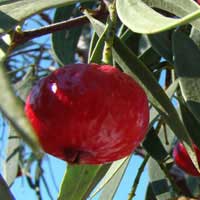 Full List of Fruits
Full List of Fruits  Quandong fruit
Quandong fruitQuandong fruit
![]() Introduction of Quandong fruit
Introduction of Quandong fruit
Scientific name - Santalum acuminatum
Quandong has a scientific name Santalum acuminatum which grows only in the deserts reigns from the Sandalwood family known to be Santalaceae. It is partially a parasitic plant originating from the desert regions of central and southern Australia. The fruit is referred to as native peach, mainly cultivated importantly for the fruits. Fruits are majorly cultivated for the wonderful flavor contained in it which helps in the preparation of all types of bush foods .The length of the fruit measures to be 20-25 mm width wise. The fruit is red in color or also yellow correctly four years after its production process takes place. The pulp is of 3mm which encloses the nut in the shape of brain with hard texture covering up a seed within it. The fruit comes under the drupe classification. After ripening turns out to be with a glossy red finish which was earlier green. Ripening takes place in the end of spring else in the end of summer too and possess a circular kind of shape with a width pertaining to 20-40 mm. The skin contains a waxy texture added on to it.
![]() Nutritional Value of Quandong fruit
Nutritional Value of Quandong fruit
| Energy | 206kJ / 100gm |
| H2O | 71.9 gm / 100 gm |
| Protein | 2.5 gm / 100 gm |
| Fat | 0 gm / 100 gm |
| Carbohydrates | 8.1 gm / 100 gm |
| Total Sugar | 8.1 gm / 100 gm |
| Fibre | 4.2 gm / 100 gm |
| Na | 306.05µg |
| K | 3456.2µg |
| Mg | 217.9µg |
| Ca | 133.3µg |
| Fe | 16.55µg |
| Zn | 4.24µg 2645 kj |
| Cu | 1.8mg |
The fruit is widely used for its flavor which is similar to that of the peach, apricot or rhubarb, commercially cultivated for its exotic flavor used in the preparation of sweets, savory foods and wide range of pastries .A peculiar Australian food additive product is prepared using Quandong for its wonderful flavor content. The fruit originates from wild trees mainly, also at times produced from the Aboriginal corporations but the reproduction of the orchards for commercial purpose is strictly not allowed. The Aboriginal people majorly collect nuts but also preferred the fruit earlier. Emu droppings are used for gathering the undigested nuts from the birds. After the peeling process the fruit has many number of applications such as production of jams, chutneys and also pies.
![]() Health Benefits of Quandong fruit
Health Benefits of Quandong fruit
The fruit is known for its purgative nature so mixed with tea and drunk to give a laxative effect. The tree’s roots have medicinal applications; their infusion is used to solve the complications of rheumatism. The mixture of leaves crushed form and saliva are used in the production of an ointment to heal skin based problems such as sores and boils. The seed inhibits an oil rich kernel which can also be crushed along with saliva to produce ointments solving skin based problems. The nuts are consumable and taken raw and the crushed nuts are used as a hair conditioning oil to nurture the hair.
 Do you know the people of Australia also call the fruit as Wild Peach, Desert Peach or also as Native Peach
Do you know the people of Australia also call the fruit as Wild Peach, Desert Peach or also as Native Peach
 Since the fruit is rich in Vitamin C contents it is used in treating scurvy and has recovered many Australian based explorers against the deficiency, Quandong fruit has more Vitamin C compared to that of Orange.
Since the fruit is rich in Vitamin C contents it is used in treating scurvy and has recovered many Australian based explorers against the deficiency, Quandong fruit has more Vitamin C compared to that of Orange.
 Amazingly the fruit can be preserved for 8 years or more too by drying and storing it in low temperatures, the fruit does not lose its flavor though it is stored for such a long period of time.
Amazingly the fruit can be preserved for 8 years or more too by drying and storing it in low temperatures, the fruit does not lose its flavor though it is stored for such a long period of time.
 The trees wood has an exotic aroma which is historically used in the celebration of ‘smoking ceremonies’ by the aboriginal people.
The trees wood has an exotic aroma which is historically used in the celebration of ‘smoking ceremonies’ by the aboriginal people.
 The Quandong fruits seeds mostly used as Chinese Checker pieces by the Australian countryside’s children.
The Quandong fruits seeds mostly used as Chinese Checker pieces by the Australian countryside’s children.
Harvest takes place in many methods, the nuts can be gathered either from their trees or through the emu bird’s droppings and the fruits are collected directly from their trees. The fruits are mainly obtained from the process of wild harvesting only. From the earlier days the colonists adopt the same methods of harvesting. Only a higher amount of rainfall can yield a sizeable amount of fruits. The natives will prefer to store the pulp for an average of 8 years and dry up the harvest for the year. This would also help solve the problem of infestation providing a good source of food and abiding all the food safety guidelines to prepare the commercial ingredient based additives. A fully mature tree can produce 10-25 kg of fruits, where 40 percent weight is kernel alone; the fruits are commercially used both fresh and dried. The nuts are consumed raw, roasted or salted too.


















